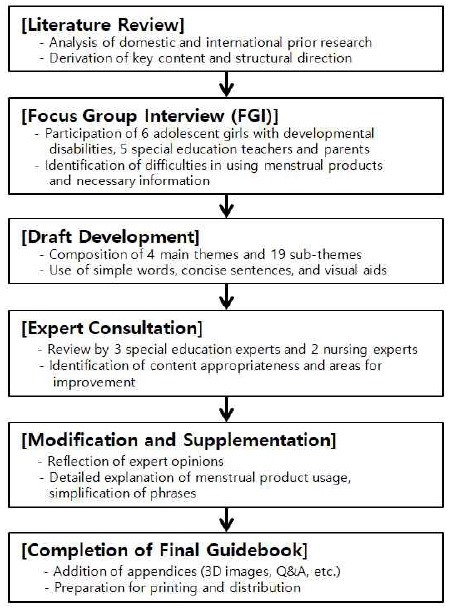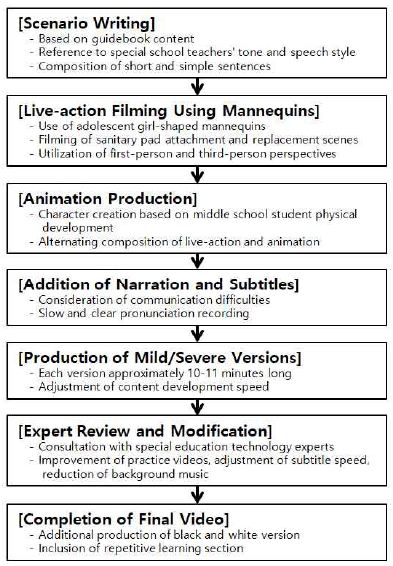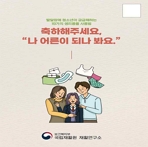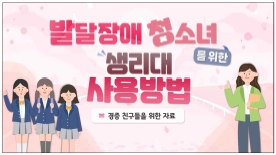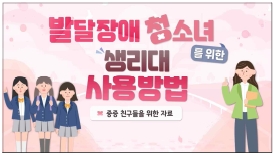
발달장애 청소녀를 위한 맞춤형 생리용품 사용 가이드북 및 교육 동영상 제작과 적용
Copyright ⓒ 2024 The Digital Contents Society
This is an Open Access article distributed under the terms of the Creative Commons Attribution Non-CommercialLicense(http://creativecommons.org/licenses/by-nc/3.0/) which permits unrestricted non-commercial use, distribution, and reproduction in any medium, provided the original work is properly cited.

초록
본 연구의 목적은 발달장애 청소녀의 생리용품 사용 이해와 자립성 향상을 위한 가이드북과 교육 동영상을 개발하고 적용하는 것이다. 연구방법은 문헌 고찰과 포커스 그룹 인터뷰(FGI), 전문가 자문 등을 통해 가이드북 최종본을 개발하고, 이를 바탕으로 경증 및 중증 발달장애 청소녀 대상의 맞춤형 생리대 사용방법 교육 동영상을 제작하였다. 개발된 자료는 FGI를 통해 정확성과 유용성을 검증받았으며, 수정 보완 후 관련 기관에 배포되었다. 연구 결과, 가이드북과 동영상을 활용한 교육은 발달장애 청소녀의 월경 관련 지식과 기술을 유의하게 향상시켰다. 본 연구는 기존의 일반적인 월경 교육 자료와 달리 발달장애 청소녀의 특성과 요구를 반영한 맞춤형 교육 자료를 개발했다는 점에서 차별화된다. 연구 결과는 발달장애인 성교육 및 건강교육 분야에서 실질적으로 활용될 수 있으며, 이들의 건강한 성장과 사회통합에 기여할 것으로 기대된다.
Abstract
This study aimed to develop and implement a guidebook and educational videos to improve the understanding of menstrual product usage and independence among adolescent girls with developmental disabilities. The research methods used to develop the final guidebook includedwere literature reviews, focus group interviews (FGI), and expert consultation, followed by the creation of customized educational videos on sanitary pad usage for girls with mild and severe developmental disabilities. The developed materials were validated for accuracy and usefulness through FGI and distributed to relevant organizations after revisions. The results showed that education using the guidebook and videos significantly improved the menstrual knowledge and skills of adolescent girls with developmental disabilities. This study differs from existing general menstrual education materials in that it developed customized educational materials reflecting the characteristics and needs of adolescent girls with developmental disabilities. The findings can be utilized in the fields of sex education and health education for individuals with developmental disabilities and are expected to contribute to their healthy growth and social integration.
Keywords:
Adolescent Girls with Developmental Disabilities, Menstrual Products, Guidebook, Educational Videos, Focus Group Interview키워드:
발달장애 청소녀, 생리용품, 가이드북, 교육 동영상, 포커스 그룹 인터뷰Ⅰ. 서 론
청소년기는 아동에서 성인으로 전환되는 시기로, 신체적, 정서적, 사회적으로 급격한 변화를 경험하는 때이다[1]. 특히 여성의 경우, 초경을 시작으로 월경이라는 새로운 변화를 맞이하게 된다[2]. 이 시기 대부분의 여성들은 월경에 대한 정보를 습득하고 위생용품을 적절히 사용하는 방법을 익혀 나가게 된다[3]. 그러나 발달장애 청소녀의 경우, 인지적 제약, 의사소통 능력의 한계, 관련 교육 기회의 부족 등으로 인해 월경 관련 지식 수준이 낮고, 생리용품 사용에 어려움을 겪는 것으로 나타났다[4],[5].
Chou 등[6]의 연구에 따르면, 발달장애 청소녀들은 초경 연령, 월경 주기와 기간, 월경 시 위생 관리 등에 대한 이해가 부족하였으며, 생리용품의 종류와 사용법을 익히는 데에도 더 많은 시간이 소요되었다. 또한 Treacy 등[7]은 현재 발달장애 청소녀를 대상으로 한 월경 및 위생용품 사용 교육이 미흡하며, 관련 교육 자료도 부족하다고 지적하였다.
이러한 어려움은 단순히 월경 관리의 문제에 그치지 않고, 발달장애 청소녀의 신체적, 정서적 건강은 물론 전반적인 삶의 질에도 영향을 미칠 수 있다[8]. 따라서 이들이 월경을 자연스러운 신체적 변화로 받아들이고, 생리용품을 적절히 사용할 수 있도록 지원하는 것이 필요하다[9].
이에 본 연구에서는 발달장애 청소녀의 생리용품 사용에 대한 이해를 돕고 자립성을 향상시킬 수 있는 맞춤형 가이드북과 교육 동영상을 개발하고 이를 적용하는 것을 목적으로 하였다. 개발 과정에서는 발달장애 특성을 반영함으로써 맞춤형 자료를 제작하고, 당사자의 의견을 적극 수렴하여 보다 실제적이고 유용한 영상을 만들고자 하였다[10]. 이는 Treacy 등[7]이 제안한 장애인 맞춤형 성교육의 필요성과 Powell 등[11]이 강조한 당사자 중심 접근법을 실현한 것이다. 이를 통해 발달장애 청소녀의 건강한 성장을 도모하고, 나아가 사회적 통합에도 기여하고자 한다[12].
본 연구의 목적을 달성하기 위한 구체적인 연구 문제는 다음과 같다. 첫째, 발달장애 청소녀를 위한 생리용품 사용 가이드북은 어떠한 내용과 형식으로 구성되어야 하는가? 둘째, 생리용품 사용 가이드북을 활용한 교육 동영상은 어떻게 제작되어야 하는가? 셋째, 개발된 가이드북과 교육 동영상은 발달장애 청소녀와 관련 전문가에 의해 어떻게 평가되는가? 넷째, 개발된 자료는 어떠한 방식으로 보급되고 활용될 수 있는가? 이상의 연구 문제를 통해 발달장애 청소녀에게 실질적으로 도움이 되는 생리용품 사용 교육 자료를 개발하고, 이를 효과적으로 현장에 적용할 수 있는 방안을 모색해 보고자 한다.
본 연구는 기존의 일반적인 월경 교육 자료와 달리 발달장애 청소녀의 특성과 요구를 반영한 맞춤형 교육 자료를 개발했다는 점에서 차별화된다. 특히 당사자와 보호자의 의견을 직접 수렴하고 장애 정도에 따른 차별화된 콘텐츠를 제공함으로써 자료의 현장 적합성을 높였다. 이는 Treacy 등이 제안한 장애인 맞춤형 성교육의 필요성과 Powell 등이 강조한 당사자 중심 접근법을 실현한 것이다[7],[11].
본 연구에 사용된 용어의 정의는 다음과 같다.
- - 발달장애 청소녀: 본 연구에서 발달장애 청소녀는 지적장애나 자폐스펙트럼장애 등 발달장애가 있는 만 12세에서 18세까지의 여성을 의미한다[13].
- - 생리용품: 생리용품이란 월경 시 경혈을 흡수하고 위생을 유지하기 위해 사용되는 제품을 말한다. 본 연구에서는 일회용 생리대, 천 생리대, 생리컵, 생리팬티 등 다양한 종류의 생리용품을 포함한다[14].
- - 가이드북: 본 연구의 가이드북은 발달장애 청소녀 스스로 생리용품을 사용하는 방법과 주의사항 등을 익힐 수 있도록 제작된 책자를 의미한다.
- - 교육 동영상: 본 연구의 교육 동영상은 가이드북의 내용을 기반으로 발달장애 청소녀의 눈높이에 맞게 생리용품 사용법을 설명하는 시청각 영상 자료를 의미한다[15].
Ⅱ. 관련 연구
2-1 기존 가이드북 및 교육 동영상 연구
발달장애 청소녀를 위한 월경 관리 교육 자료 개발에 관한 기존 연구들을 살펴보면, Altundağ & Çalbayram[16]은 지적장애 여학생을 대상으로 월경 관리 기술 교육 프로그램을 개발하고 그 효과를 평가하였다. 이들은 주로 강의식 교육과 실습을 병행하는 방식을 채택하였으나, 개별화된 접근은 부족했다는 한계가 있었다.
Kırbaş 등[17]의 연구에서는 또래 교육을 활용한 월경 위생 교육 프로그램을 제안하였다. 이 연구는 사회적 상호작용을 통한 학습 효과를 강조했다는 점에서 의의가 있으나, 장애 정도에 따른 차별화된 접근이 미흡했다.
2-2 본 연구에서 제안한 기술과의 차이점
본 연구에서 제안한 가이드북 및 교육 동영상은 기존 연구들과 다음과 같은 차이점을 갖는다.
- 1) 맞춤형 접근: 장애 정도(경증/중증)에 따라 차별화된 콘텐츠를 제공하여 개별 학습자의 특성을 고려하였다.
- 2) 멀티미디어 활용: 애니메이션과 실사 영상을 효과적으로 조합하여 학습자의 이해와 주의 집중을 높였다.
- 3) 당사자 참여: 발달장애 청소녀와 그 가족, 교사들의 의견을 직접 수렴하여 현장의 요구를 충실히 반영하였다.
- 4) 실생활 중심 내용: 일상생활에서 실제 적용 가능한 구체적인 사례와 전략을 제시하였다.
- 5) 반복 학습 강화: 핵심 내용에 대한 반복 학습 섹션을 추가하여 학습 효과를 높였다.
이러한 특징들을 통해 본 연구는 발달장애 청소녀의 월경 관리 역량 향상에 보다 효과적으로 기여할 수 있을 것으로 기대된다.
Ⅲ. 연구방법
3-1 연구 설계
본 연구는 발달장애 청소녀를 위한 생리용품 사용 가이드북과 교육 동영상을 개발하고 적용하는 과정을 담고 있다. 연구 진행을 위해 질적 연구방법과 양적 연구방법을 함께 사용하는 혼합연구방법을 활용하였다[18]. 이는 Lundgren & Amin[19]의 청소년 성교육 연구에서 사용된 방법을 참고한 것으로, 복잡한 사회현상을 다각도로 이해하고 풍부한 데이터를 수집하기 위함이다. 구체적으로 FGI를 통한 질적 자료 수집과 설문조사를 통한 양적 자료 수집을 병행하였으며, 순차적 설명 설계(Sequential Explanatory Design)를 채택하였다. 구체적으로는 선행연구 고찰, 포커스 그룹 인터뷰(FGI), 전문가 자문, 설문조사 등을 통해 자료를 수집하고 분석하였다(표 1)[4],[7],[10],[16].
3-2 연구 절차
문헌 고찰을 통해 발달장애 청소녀의 월경 및 생리용품 사용 관련 선행연구[5],[7],[20],[21]를 중점 분석하였다. 이를 통해 가이드북에 포함할 주요 내용과 구성 방향을 도출하였다. 발달장애 청소녀 당사자 6명과 특수교사 및 부모 5명을 대상으로 FGI를 실시하여 생리용품 사용 시 겪는 어려움과 필요한 정보에 대해 심층적으로 알아보았다. FGI 참여자는 의사소통이 가능한 만 12세에서 15세의 경증 및 중등도 지적장애 또는 자폐성 장애 청소녀, 이들의 어머니, 그리고 발달장애 성교육 지도 경력 3년 이상의 특수교사 등으로 선정하였다. 학교와 학부모의 추천, 관련 학회 및 협회를 통해 참여자를 모집하였다. 문헌 고찰과 FGI 결과를 바탕으로 가이드북 초안을 구성하였다. 초안은 특수교육 전문가 3인과 간호학 전문가 2인의 자문을 받아 수정 보완하였다.
완성된 생리용품 사용 가이드북을 토대로 교육 동영상의 시나리오를 작성하였다. 가이드북 내용 중 생리대 사용방법 학습에 대한 요구도가 큼에 따라 영상 개발 주제는 생리대 사용방법으로 정했다[22]. 시나리오는 실제 특수학교 선생님들의 수업 시 사용하는 어조, 말투, 말의 속도 등을 참고하고[16], 발달장애 청소녀의 인지적 특성[23]을 고려하여 짧고 단순한 문장으로 구성하였다. 시나리오를 바탕으로 청소녀 모습의 마네킹을 활용해 실사 형태의 교육용 동영상을 촬영하였다. 발달장애 청소년들이 사용해야 되는 도구, 현상, 상황을 중심으로 1인칭 및 3인칭 시점[24]을 이용했다. 영상 이해에 필요한 인지 수준을 고려하여, 장애 정도(경증 또는 중증)에 따라 별도의 동영상을 제작하였다[25]. 제작된 동영상은 특수교육공학 전문가의 자문을 받아 애니메이션, 자막, 음성해설 등의 멀티미디어 요소를 추가하였다[26]. 애니메이션 캐릭터는 1명으로 중학생 정도의 신체발달을 기준으로 제작하였다.
A, B 두 개 지역에 소재한 4개 특수학교의 발달장애 청소녀 20명을 연구 참여자로 선정하였다. 사전검사로 참여자의 월경 및 생리용품 사용에 대한 지식과 기술을 평가하는 설문조사를 실시하였다. 1주일 간 개발된 동영상을 활용한 교육을 진행하였다[27]. 교육은 특수교사와 보건교사가 함께 진행하였다. 교육 종료 후, 사후검사를 실시하여 월경 및 생리용품 사용 지식과 기술의 변화를 살펴보았다. 교육에 참여한 발달장애 청소녀 20명과 교사 10명, 학부모 10명을 대상으로 동영상의 만족도 및 수정 보완 사항에 대한 설문조사를 진행하였다[28],[29]. 설문조사 결과를 반영하여 동영상을 최종 수정하였다.
3-3 자료 분석
수집된 자료는 양적 자료와 질적 자료로 나누어 분석하였다. 설문조사를 통해 수집된 양적 자료는 SPSS 22.0 프로그램을 이용하여 기술통계와 대응표본 t-검정을 실시하였다. FGI를 통해 수집된 질적 자료는 내용분석 방법을 활용하여 범주화하였다[30],[31]. 가이드북과 동영상의 초안 및 최종안에 대한 전문가 검토 내용은 서술적으로 제시하였다.
3-4 연구의 타당도와 신뢰도
연구의 타당도와 신뢰도를 높이기 위해 다음과 같은 방법을 활용하였다. 첫째, 장애 및 건강 전문가로 구성된 연구팀이 가이드북 및 영상 개발 전 과정에 함께 참여하여 연구 설계부터 자료 해석에 이르기까지 동료 간 협의를 거쳤다. 둘째, 연구 참여자 선정 시 장애 정도와 학교 특성을 고려하여 대표성을 확보하고자 하였다[31],[32]. 셋째, FGI 결과는 연구 참여자에게 다시 확인하는 과정을 거쳐 진술 내용의 정확성을 높였다[33]. 넷째, 가이드북과 동영상 개발 과정에서 특수교육, 사회복지, 특수교육공학, 간호학 등 다양한 전문가의 자문을 받아 내용 타당도를 확보하였다[26],[34].
Ⅳ. 결과
4-1 발달장애 청소녀의 월경 및 생리용품 사용 관련 요구
발달장애 청소녀의 월경에 관한 국내외 주요 선행연구를 분석한 결과, 이들은 비장애 청소녀에 비해 월경 관련 지식 수준이 낮고, 생리용품 사용에 어려움을 겪는 것으로 나타났다. 구체적으로 초경 연령, 월경 주기와 기간, 월경 시 위생 관리 등에 대한 이해가 부족하였으며, 생리용품의 종류와 사용법을 익히는 데 더 많은 시간이 소요되었다. 또한 월경과 관련된 통증이나 불편감을 표현하는 데 어려움을 겪는 경우가 많았다. 이러한 어려움의 원인으로는 발달장애 청소녀의 인지적 제약, 언어 및 의사소통 능력의 한계, 관련 교육 기회의 부족 등이 지적되었다. 이를 해결하기 위해서는 이들의 특성을 고려한 반복적이고 체계적인 교육, 시청각적 자료의 활용, 부모와 교사의 적극적인 지원 등이 필요함을 알 수 있었다(표 2).
월경을 시작한 발달장애 청소녀 6명과 이들을 지도한 경험이 있는 특수교사 및 부모 5명을 대상으로 FGI를 실시한 결과는 다음과 같다.
• 발달장애 청소녀의 월경 및 생리용품 사용 경험
발달장애 청소녀들은 대부분 초경을 맞이했을 때 당황스러워하거나 두려워하는 모습을 보였다. 이는 사전에 월경에 대해 충분히 알지 못했기 때문으로 보인다. 이들은 생리대 교체 시기를 알기 어려워하고, 올바른 착용법을 익히는 데 시행착오를 겪었다. 생리대 외에 다른 생리용품을 사용하는 경우는 거의 없었으며, 특히 중증 발달장애 청소녀의 경우 대부분 일회용 생리대에 의존하고 있었다.
• 발달장애 청소녀의 월경 및 생리용품 사용 교육 경험
FGI에 참여한 발달장애 청소녀들은 학교나 가정에서 체계 적인 월경 교육을 받은 경험이 거의 없었다. 교사들 역시 관련 지식이나 교수 경험이 부족하여 월경 지도에 어려움을 느끼고 있었다. 참여자들은 발달장애 청소녀의 특성에 맞는 맞춤형 교육 자료와 지침서의 필요성을 강조하였다.
• 발달장애 청소녀를 위한 생리용품 사용 가이드북과 교육 동영상에 대한 요구
참여자들은 가이드북과 동영상에 발달장애 청소녀들이 생리용품을 사용하는 구체적인 방법이 단계별로 제시되기를 원하였다. 이때 그림이나 사진을 활용하여 시각적으로 표현하는 것이 효과적일 것이라고 하였다. 또한 실제 발달장애 청소녀가 출연하는 동영상을 선호하였으며, 자막이나 수어 등 보완대체 의사소통 도구가 함께 제공되기를 바랐다. 더불어 생리용품 선택부터 구매, 사용 후 처리까지 전 과정에 대한 정보가 포함되어야 한다는 의견이 있었다.
4-2 생리용품 사용 가이드북 개발 최종 결과
생리용품 사용 가이드북은 발달장애 청소녀용(당사자용)으로 제작되었다. 발달장애 청소녀용 가이드북의 구성은 표 3과 같다.

Contents of the menstrual product usage guidebook for adolescent girls with developmental disabilities
가이드북은 총 4개의 대주제(‘몸의 변화’, ‘월경에 대한 이해’, ‘생리용품에 대한 이해’, ‘다양한 상황에서 생리용품 사용하기’)와 19개의 소주제로 구성되었으며, 각 주제별로 2-3페이지 분량의 내용을 담고 있다. 발달장애인의 인지 수준을 고려하여 모든 페이지에 각 소주제별로 핵심 내용을 쉬운 단어, 간결한 문장, 이해하기 쉬운 그림으로 설명하였으며, 일러스트레이션과 사진과 같은 시각적 자료를 적극 활용하여 발달장애 청소녀의 이해를 도왔습니다. 아울러 생활 속 실제 상황을 반영한 사례형 그림을 제시하여 실생활에서의 적용을 용이하게 하였습니다. 또한, 생리용품 사용법을 단계별로 상세히 설명하여 쉽게 따라할 수 있도록 구성하였다.
부록에서는 실제 생리용품 크기를 3D 이미지로 제시하거나, 월경 관련 주요 질문을 Q&A 형식으로 다루는 등 발달장애 청소녀의 이해를 돕고 흥미를 유발하는 보조 자료들도 수록하였다.
전문가 검토 결과, 가이드북은 발달장애 청소녀의 특성을 잘 반영하고 있으며, 구성과 내용이 적절한 것으로 평가되었다. 다만, 월경 용품의 구체적 사용 방법에 관한 내용을 추가하고, 각 장에 더 간결한 문구를 기술하는 것이 좋겠다는 의견이 제시되어 이를 수정 보완하였다.
가이드북 개발 과정에서 FGI와 문헌고찰을 통해 도출된 주요 내용은 다음과 같이 반영되었다. ‘쉬운 용어와 시각자료 활용’, ‘단계별 상세 설명 제공’, ‘실제 상황 중심의 예시 포함’. 교육 동영상 시나리오 작성 시 주요 이슈는 내용의 난이도 조절과 주의 집중 유도였으며, 이를 위해 특수교육 전문가의 자문을 받아 용어를 수정하고, 애니메이션과 실사를 적절히 혼용하여 주의 집중을 높였다(그림 1).
4-3 생리대 사용법 교육 동영상 제작 최종 결과
최종 ‘생리대 사용법 교육 동영상’은 가이드북의 내용을 바탕으로 경증 발달장애 청소녀와 중증 발달장애 청소녀를 위한 맞춤형 버전으로 나누어 제작되었다. 또한, 발달장애인의 인지 특성 관련, 많은 색감에 의해 집중도가 저할될 수 있음을 고려하여 흑백 버전의 동영상도 개발하였다. 동영상에는 청소녀 마네킹을 활용하여 실제로 생리대를 착용하고 교체하는 실사 장면을 담았고, 이를 통해 학습자의 공감을 이끌어내고자 하였다(표 4).
애니메이션, 실사 영상, 자막, 나레이션을 교차적으로 사용하고, 실습하는 과정을 효과적으로 조합해 반복하여 제시하였다. 현실과 동떨어진 비현실적인 캐릭터가 주는 단점을 고려하여, 최종 사용 캐릭터는 실제 학습 대상자와 유사한 느낌으로 제작하였다. 기존 일반 성교육 콘텐츠보다 학습 내용 전개 속도 등을 느리게 하여 발달장애인의 인지 수준에 맞췄다.
경증용 및 중증용 최종 동영상은 각각 10분, 11분 내외로 구성하고, 의사소통에 어려움이 있는 발달장애인도 시청을 통해 내용을 이해할 할 수 있도록 나레이션과 자막을 활용했다. 월경의 의미, 생리대 사용방법, 생리대 교체 시기, 생리대 교체 방법, 월경 시 주의사항 등에 대해 비교적 자세한 내용을 다루고, 이를 실사 영상과 애니메이션을 이용해 설명했다. 생리대 사용방법 파트의 경우, 실제 시범 영상을 제시하고, 이를 반복 연습할 수 있는 영상도 포함하였다. 핵심 내용에 대한 반복 학습 섹션을 포함하여 이해도를 높였고, 생리대 사용방법에 대한 실제 시범 영상을 포함해 실습이 가능하도록 하였다.
경증 및 중증 영상 모두 공통 내용으로 구성하되, 일부 제시 형식에 차이를 두었다. 예컨대 ‘반복학습’ 파트의 경우, 경증용에서는 ‘생리대 사용방법’ 파트와 달리 에니메이션으로 제시한 반면, 중증용에서는 ‘생리대 사용방법’ 파트와 동일하게 실사 영상으로 제시하여 반복적인 재학습을 강조하는 식이다.
최종 전문가 검토 결과, 동영상은 발달장애 청소녀의 눈높이에 맞는 내용과 표현으로 구성되었다고 평가되었다. 개선사항으로는 연습 영상을 보완하고, 자막의 속도를 좀 더 느리게 하며, 배경음악을 줄이는 것 등이 제안되었다.
이처럼 발달장애 청소녀의 인지 및 이해 수준을 고려한 차별화된 내용 구성과 더불어, 경증-중증 자료의 연계성을 고려한 내용 배열, 반복 학습이 가능한 형태의 구성 등을 통해 교육 자료로서의 효과성을 높이고자 하였다(그림 2).
4-4 교육 동영상의 적용 효과
동영상을 활용한 교육에 참여한 발달장애 청소녀의 월경 및 생리용품 관련 지식과 기술은 유의하게 향상되었다. 표 5에 제시된 바와 같이, 지식 점수의 경우 사전 평균 50.5점에서 사후 평균 85.3점으로 큰 폭으로 증가하였다(t=-10.25, p<.001). 기술 점수 역시 교육 전 평균 48.2점에서 교육 후 평균 88.7점으로 유의하게 높아졌다(t=-12.38, p<.001). 이는 본 연구에서 개발된 자료가 발달장애 청소녀의 월경 관련 역량 강화에 효과적임을 보여준다. 비록 통제집단을 두지는 않았으나, 대상자 내 변화를 비교한 결과 교육의 효과가 통계적으로 입증되었다는 점에서 개발된 교육 자료의 유용성을 확인할 수 있었다.
교육에 참여한 발달장애 청소녀와 교사, 학부모를 대상으로 실시한 만족도 평가 결과는 표 6과 같다. 전반적으로 교육 내용과 방법, 자료의 적절성, 도움 정도 등에서 높은 만족감을 나타냈다. 특히 학습자의 수준을 고려한 자료 구성, 실습 기회 제공, 부모 참여 등의 항목에서 긍정적인 반응을 보였다.
청소녀들은 “그림으로 설명해 주니까 이해가 잘 됐어요”, “영상을 보면서 직접 해보니까 덜 어색했어요” 등의 의견을 주었다. 교사들은 “학생의 장애 특성에 맞는 자료여서 지도하기에 용이했다”, “단계별로 자세하게 안내되어 있어 수업에 큰 도움이 되었다”고 평하였다. 부모들은 “아이가 월경을 긍정적으로 받아들이게 된 계기가 되었다”, “선생님과 함께 교육에 참여하면서 가정에서도 지도할 수 있는 방법을 배울 수 있었다”는 반응을 보였다.
4-5 가이드북 및 교육 동영상 활용 방안
개발된 가이드북과 교육 동영상은 다양한 환경에서 활용될 수 있도록 설계되었다. 우선 특수학교의 보건 교육 시간에 이 자료들을 활용할 수 있다. 교사들은 가이드북을 참고하여 수업을 구성하고, 동영상을 시청각 자료로 활용함으로써 발달장애 청소녀들의 이해를 돕고 효과적인 교육을 진행할 수 있다.
가정에서도 이 자료들은 유용하게 사용될 수 있다. 부모가 자녀에게 월경 관리를 지도할 때 참고 자료로 활용할 수 있으며, 편안한 분위기 속에서 가이드북을 함께 보며 설명하고 동영상을 시청하면서 실제적인 지도가 가능하다.
또한 이 자료들은 발달장애 청소녀의 자기 학습을 위한 도구로도 활용 가능하다. 반복적으로 가이드북을 읽고 동영상을 시청함으로써 자기 주도적 학습이 가능하며, 이는 자립성 향상에도 도움이 될 수 있다.
교사 연수 자료로도 활용될 수 있는데, 특수교사 및 보건교사들이 발달장애 청소녀의 월경 교육에 대한 이해를 높이고 효과적인 지도 방법을 학습하는 데 도움이 될 수 있다.
마지막으로, 이 자료들은 온라인을 통해 폭넓게 배포된다. 국립재활원 홈페이지와 유튜브 채널을 통해 누구나 쉽게 접근하여 활용할 수 있도록 하였다. 이를 통해 시간과 장소에 구애받지 않고 필요한 정보를 얻을 수 있으며, 더 많은 발달장애 청소녀와 그 가족들에게 도움을 줄 수 있을 것으로 기대된다.
4-6 가이드북과 교육 동영상의 보급 및 확산
최종 가이드북은 전국 보건소와 장애인복지관, 장애인보건의료센터, 발달장애 유관 기관 등에 배포되었다. 최종 개발된 동영상은 연구에 참여한 4개교를 포함하여 전국 30개 특수학교에 배포되어 발달장애 청소녀 교육에 활용될 예정이다. 동영상은 각 학교 홈페이지와 학부모 커뮤니티를 통해 온라인으로도 공유되었다.
본 연구진은 연구 및 개발 과정 공유, 확대보급을 위해 산출물과 관련 연구자료 등을 국립재활원 홈페이지, 유튜브 채널 등에 공유하였다. 누구나 쉽게 접근하여 활용할 수 있도록 자료를 게시하였으며, 사용자의 피드백을 반영하여 지속적으로 업데이트할 예정이다. 참여자들은 발달장애 청소녀의 실제적 요구를 반영한 자료 개발의 의의를 높이 평가하였으며, 추후 장애 유형과 정도를 확대한 자료 제작의 필요성을 제안하였다.
Ⅴ. 논의 및 제언
본 연구는 발달장애 청소녀의 월경 및 위생관리에 관한 교육 요구를 반영한 실용적인 가이드북과 교육 동영상을 개발했다는 데 의의가 있다[4],[5]. 기존의 선행연구들이 주로 발달장애 청소녀의 월경 문제 실태와 인식을 조사하는 데 그친 것에 비해[12],[20], 이 연구는 교육 자료 개발로 나아갔다는 점에서 차별화된다. 또한 자료 제작 과정에서 당사자의 목소리를 직접 반영하고, 장애 특성에 기반한 교수 전략을 적용함으로써 자료의 현장 활용도를 높이고자 하였다[10],[30].
연구 결과, 개발된 가이드북과 동영상은 발달장애 청소녀의 월경 관련 지식과 기술을 향상시키는 데 효과적인 것으로 나타났다[22],[27]. 이는 본 연구에서 제시한 교육 내용과 방법이 이들의 학습을 촉진하는 데 도움이 되었음을 시사한다. 나아가 참여자들이 월경을 보다 긍정적으로 인식하게 되었다는 점에서 자료가 인식 개선에도 기여할 수 있음을 엿볼 수 있다[31]. 이러한 결과는 장애 학생의 교육에서 개별화와 맞춤형 지원의 중요성을 다시 한번 상기시킨다[29].
본 연구의 결과는 Tracy 등[35]과 Quint[36]의 연구에서 제시된 발달장애 청소녀의 월경 관리 개선을 위한 권장사항과 일치한다. Tracy 등은 월경 교육 자료가 이들의 신체적 자율성을 증진시키는 데 긍정적인 영향을 미칠 수 있음을 강조하며, Quint는 월경 관리 교육이 발달장애 청소녀의 자신감 향상에 기여할 수 있다고 보고하였다. 이러한 이전 연구들과 본 연구의 결과를 비교해 볼 때, 본 연구가 개발한 교육 자료는 효과적인 월경 관리 뿐만 아니라 월경과 관련된 긍정적 태도 형성에도 기여한 것으로 평가될 수 있다[22],[28].
또한, 본 연구는 발달장애 청소녀의 월경 관리를 지원하기 위한 교육 자료 개발에 있어서 당사자와 보호자의 목소리를 직접 반영한 점에서 선행 연구들과 차별화된다[29]. 이는 Griffin 등[37]이 지적한 연구 접근법과 일치하며, 장애 연구에서 당사자 중심의 접근이 갖는 중요성을 재확인시켜 준다.
본 연구는 특수교육 분야에서 발달장애 학생의 성교육 및 보건교육과 관련하여 실제적인 함의를 제공한다. 우선 발달장애 청소녀의 월경교육에 활용 가능한 구체적인 교육 자료와 지도 방안을 제시함으로써 교사들의 수업 설계와 교수학습 활동에 도움이 될 것으로 기대된다[5],[20]. 또한 가이드북은 부모가 가정에서 자녀의 월경을 지도하는 데에도 유용한 자료로 쓰일 수 있을 것이다[4]. 이를 통해 학교와 가정이 연계하여 발달장애 청소녀의 월경을 지원하는 토대가 마련될 수 있을 것이다.
더 나아가 연구 과정과 결과는 장애인의 성 권리 증진과 건강한 발달을 위한 지역사회의 노력에 시사점을 준다. 본 연구는 장애인의 성에 대한 왜곡된 인식을 바로잡고 이들의 성적 자기결정권 신장을 도모하는 실천의 일환으로 이해될 수 있다[35]. 장애인 당사자와 가족의 목소리에 귀를 기울이고, 이들을 지원하는 네트워크를 구축한 것은 장애 연구의 중요한 방향성을 보여준다. 이러한 접근은 특수교육 분야를 넘어 보건의료, 사회복지 등 유관 영역의 장애 연구와 실천에 적용될 필요가 있다.
본 연구의 제한점과 이를 보완할 수 있는 후속 연구에 대해 다음과 같이 제언하고자 한다.
첫째, 이 연구는 일부 지역의 특수학교에 재학 중인 발달장애 청소녀를 대상으로 하였기에 연구 결과를 일반화하기에는 한계가 있다[29]. 추후 연구에서는 다양한 지역과 학교급, 장애 정도의 대상을 포함하여 연구 결과의 보편성을 확보할 필요가 있다.
둘째, 개발된 가이드북과 동영상의 장기적인 효과성에 대한 검증이 이루어지지 않았다. 월경은 반복적으로 경험하게 되는 신체 사건이므로, 일회성 교육보다는 주기적인 중재가 필요하다[27]. 따라서 후속 연구에서는 종단적 설계를 통해 교육 효과의 지속성과 일상에서의 적용 정도를 확인하고, 필요시 추가적인 지원 방안을 모색해야 할 것이다.
셋째, 이 연구에서는 양적 평가에 초점을 두어 발달장애 청소녀의 지식 및 기술의 변화 정도를 살펴보았다. 그러나 월경 경험과 관련된 정서, 인식, 태도 등의 변화를 깊이 있게 탐색하기 위해서는 질적 연구방법을 활용할 필요가 있다[24],[30]. 심층 면담이나 참여관찰 등을 통해 당사자의 관점에서 월경의 의미와 경험을 해석하는 작업이 요청된다.
넷째, 본 연구는 발달장애 '청소녀'에 한정하여 이루어진 만큼, 성인기 이후의 발달장애 여성의 월경 문제는 다루지 못하였다. 추후 연구를 통해 전 생애에 걸친 발달장애 여성의 월경 및 재생산건강 주제를 조명하고, 연령대별로 차별화된 지원 전략을 모색할 필요가 있다[22].
다섯째, 발달장애 청소녀가 월경을 자연스럽고 건강한 과정으로 받아들이기 위해서는 이들을 둘러싼 환경의 변화가 뒷받침되어야 한다. 이를 위해 부모와 교사의 인식 개선, 또래 학생들의 이해 증진을 위한 노력이 병행되어야 한다[5],[25]. 나아가 장애 여성의 성 권리를 보장하는 사회적 인프라와 정책적 지원 체계가 구축되어야 할 것이다. 이는 후속 연구의 중요한 과제로 남겨둔다.
이상의 연구 결과와 제언을 토대로, 본 연구가 발달장애 청소녀의 월경 교육 및 지원을 위한 실천적, 정책적 노력을 촉발하는 계기가 되기를 기대한다. 아울러 장애인의 성 건강 증진을 위한 연구와 실천이 보다 활발히 이루어지기를 희망하며, 이 과정에서 당사자의 목소리가 반영되고 그들의 권리가 실현될 수 있도록 노력해야 할 것이다.
Ⅵ. 결 론
본 연구는 발달장애 청소녀의 월경에 대한 이해와 대처 능력 향상을 위해 맞춤형 가이드북과 교육 동영상을 개발하고 적용하는 과정을 담고 있다. 문헌 고찰과 요구도 분석을 통해 파악된 발달장애 청소녀의 월경 관련 특성과 어려움을 반영하여 가이드북 형식의 교육 자료를 구성하였으며, 장애 정도에 따른 차별화된 동영상 콘텐츠를 개발해 제공하였다. 개발 과정에서 발달장애 당사자와 부모, 교사의 의견을 적극 수렴함으로써 자료의 현장 적합성을 높이고자 하였다.
연구 결과, 가이드북과 동영상을 활용한 교육 프로그램은 발달장애 청소녀의 월경에 대한 지식과 기술을 유의하게 향상시키는 것으로 나타났다. 또한 교육에 참여한 당사자와 부모, 교사의 만족도 역시 높게 나타나 자료의 유용성이 입증되었다. 이는 장애 학생을 위한 교육 자료 제작 시 이들의 특성과 요구에 부합하는 내용 구성, 반복 학습과 시청각 자료의 활용, 실습 기회 제공 등이 효과적임을 시사한다.
본 연구는 특수교육 분야에서 발달장애 학생의 성교육 및 보건교육과 관련하여 발달장애 청소녀의 월경 관리 역량 강화를 위한 맞춤형 도구를 개발하고 실제적인 방안을 모색했다는 데 의의가 있다. 후속 연구에서는 개발된 자료의 장기적 효과성을 종단 연구를 통해 검증할 필요가 있으며, 이전 연구 등을 참고하여 성인기 발달장애 여성의 월경 및 생식건강 지원 방안에 대한 탐색도 요구된다.
교사들은 본 연구에서 제시된 가이드북과 동영상을 활용하여 발달장애 학생의 월경교육을 내실화할 수 있을 것이다. 또한 부모들은 가정에서 자녀의 초경 준비와 월경 관리를 지원하는 데 도움을 얻을 수 있을 것으로 기대된다.
Acknowledgments
본 연구는 2022년~2024년 보건복지부 위탁 ‘장애인 건강보건관리사업’의 지원을 받아 수행되었습니다. 관계부처에 감사드립니다. 또한, 본 연구는 보건복지부 국립재활원 재활연구개발용역사업(R&D) 재활연구개발지원사업 연구개발용역과제(NRCRSP-EX23009)로 수행되었습니다.
References
-
L. Steinberg, “Cognitive and Affective Development in Adolescence,” Trends in Cognitive Sciences, Vol. 9, No. 2, pp. 69-74, February 2005.
[https://doi.org/10.1016/j.tics.2004.12.005]

-
L. F. Cardoso, A. M. Scolese, A. Hamidaddin, and J. Gupta, “Period Poverty and Mental Health Implications among College-Aged Women in the United States,” BMC Women’s Health, Vol. 21, 14, January 2021.
[https://doi.org/10.1186/s12905-020-01149-5]

- J. R. Akpenpuun and P. M. Azende, “Menstrual Knowledge and Practices among Adolescent Females in Makurdi Metropolis,” Global Journal of Interdisciplinary Social Sciences, Vol. 3, No. 3, pp. 113-121, May-June 2014.
- M. P. McCabe and R. A. Cummins, “The Sexual Knowledge, Experience, Feelings and Needs of People with Mild Intellectual Disability,” Education and Training in Mental Retardation and Developmental Disabilities, Vol. 31, No. 1, pp. 13-21, March 1996.
-
P. Schaafsma, G. Kok, J. M. T. Stoffelen, and L. M. G. Curfs, “Identifying Effective Methods for Teaching Sex Education to Individuals with Intellectual Disabilities: A Systematic Review,” The Journal of Sex Research, Vol. 52, No. 4, pp. 412-432, 2015.
[https://doi.org/10.1080/00224499.2014.919373]

-
Y.-C. Chou, Z.-Y. Lu, and C.-Y. Pu, “Attitudes toward Male and Female Sexuality among Men and Women with Intellectual Disabilities,” Women & Health, Vol. 55, No. 6, pp. 663-678, 2015.
[https://doi.org/10.1080/03630242.2015.1039183]

-
A. C. Treacy, S. S. Taylor, and T. V. Abernathy, “Sexual Health Education for Individuals with Disabilities: A Call to Action,” American Journal of Sexuality Education, Vol. 13, No. 1, pp. 65-93, 2018.
[https://doi.org/10.1080/15546128.2017.1399492]

-
N. Schaafsma, G. Kok, J. M. T. Stoffelen, and L. M. G. Curfs, “People with Intellectual Disabilities Talk about Sexuality: Implications for the Development of Sex Education,” Sexuality and Disability, Vol. 35, pp. 21-38, March 2017.
[https://doi.org/10.1007/s11195-016-9466-4]

-
M. Borawska-Charko, P. Rohleder, and W. M. L. Finlay, “The Sexual Health Knowledge of People with Intellectual Disabilities: A Review,” Sexuality Research and Social Policy, Vol. 14, No. 4, pp. 393-409, December 2017.
[https://doi.org/10.1007/s13178-016-0267-4]

-
P. T. Shattuck, G. I. Orsmond, M. Wagner, and B. P. Cooper, “Participation in Social Activities Among Adolescents with an Autism Spectrum Disorder,” PLoS ONE, Vol. 6, No. 11, e27176, November 2011.
[https://doi.org/10.1371/journal.pone.0027176]

-
R. M. Powell, S. L. Parish, M. Mitra, and E. Rosenthal, “Role of Family Caregivers Regarding Sexual and Reproductive Health for Women and Girls with Intellectual Disability: A Scoping Review,” Journal of Intellectual Disability Research, Vol. 64, No. 2, pp. 131-157, February 2020.
[https://doi.org/10.1111/jir.12706]

-
R. Widyaningrum and I. N. Siwi, “The Effect of Sex Education on Knowledge and Attitude in Adolescent with Intellectual Dissability in SLB N 1 Bantul,” Journal of Nursing Practice, Vol. 2, No. 1, pp. 33-41, October 2018.
[https://doi.org/10.30994/jnp.v2i1.40]

-
E. Simonoff, A. Pickles, T. Charman, S. Chandler, T. Loucas, and G. Baird, “Psychiatric Disorders in Children with Autism Spectrum Disorders: Prevalence, Comorbidity, and Associated Factors in a Population-Derived Sample,” Journal of the American Academy of Child & Adolescent Psychiatry, Vol. 47, No. 8, pp. 921-929, August 2008.
[https://doi.org/10.1097/CHI.0b013e318179964f]

-
A. R. Casola, K. Luber, A. H. Riley, and L. Medley, “Menstrual Health: Taking Action against Period Poverty,” American Journal of Public Health, Vol. 112, No. 3, pp. 374-377, March 2022.
[https://doi.org/10.2105/AJPH.2021.306622]

-
I. Øien, B. Fallang, and S. Østensjø, “Everyday Use of Assistive Technology Devices in School Settings,” Disability and Rehabilitation: Assistive Technology, Vol. 11, No. 8, pp. 630-635, 2016.
[https://doi.org/10.3109/17483107.2014.1001449]

-
S. Altundağ and N. Ç. Çalbayram, “Teaching Menstrual Care Skills to Intellectually Disabled Female Students,” Journal of Clinical Nursing, Vol. 25, No. 13-14, pp. 1962-1968, July 2016.
[https://doi.org/10.1111/jocn.13215]

-
Z. Ö. Kırbaş, İ. Kahriman, and Y. Kaşko Arıcı, “Training Female Adolescent Students with Intellectual Disabilities about Genital Hygiene Skills Using Peer Training,” International Journal of Developmental Disabilities, Vol. 68, No. 3, pp. 332-341, 2022.
[https://doi.org/10.1080/20473869.2020.1774224]

-
D. L. Oswald, E. K. Clark, and C. M. Kelly, “Friendship Maintenance: An Analysis of Individual and Dyad Behaviors,” Journal of Social and Clinical Psychology, Vol. 23, No. 3, pp. 413-441, June 2004.
[https://doi.org/10.1521/jscp.23.3.413.35460]

-
R. Lundgren and A. Amin, “Addressing Intimate Partner Violence and Sexual Violence among Adolescents: Emerging Evidence of Effectiveness,” Journal of Adolescent Health, Vol. 56, No. 1, pp. S42-S50, January 2015.
[https://doi.org/10.1016/j.jadohealth.2014.08.012]

-
A. Barak and W. A. Fisher, “Toward an Internet‐Driven, Theoretically‐Based, Innovative Approach to Sex Education,” The Journal of Sex Research, Vol. 38, No. 4, pp. 324-332, 2001.
[https://doi.org/10.1080/00224490109552103]

-
H. Ditchfield and J. Burns, “Understanding Our Bodies, Understanding Ourselves: The Menstrual Cycle, Mental Health and Women With Learning Disabilities,” Tizard Learning Disability Review, Vol. 9, No. 4, pp. 24-32, October 2004.
[https://doi.org/10.1108/13595474200400035]

- M. McCarthy, “Women with Intellectual Disability: Their Sexual Lives in the Light of Article 16 of the Convention on the Rights of Persons with Disabilities,” Journal of Law and Medicine, Vol. 18, No. 4, pp. 744-769, June 2011.
-
E. H. Quint, “Menstrual and Reproductive Issues in Adolescents with Physical and Developmental Disabilities,” Obstetrics & Gynecology, Vol. 124, No. 2 part 1, pp. 367-375, August 2014.
[https://doi.org/10.1097/AOG.0000000000000387]

-
N. D. Brener, L. Kann, T. McManus, S. A. Kinchen, E. C. Sundberg, and J. G. Ross, “Reliability of the 1999 Youth Risk Behavior Survey Questionnaire,” Journal of Adolescent Health, Vol. 31, No. 4, pp. 336-342, October 2002.
[https://doi.org/10.1016/S1054-139X(02)00339-7]

-
B. L. Murray, “Sexual Health Education for Adolescents with Developmental Disabilities,” Health Education Journal, Vol. 78, No. 8, pp. 1000-1011, December 2019.
[https://doi.org/10.1177/0017896919859605]

-
L. Barnard-Brak, M. Schmidt, S. Chesnut, T. Wei, and D. Richman, “Predictors of Access to Sex Education for Children with Intellectual Disabilities in Public Schools,” Intellectual and Developmental Disabilities, Vol. 52, No. 2, pp. 85-97, April 2014.
[https://doi.org/10.1352/1934-9556-52.2.85]

-
Y. A. Kirkham, L. Allen, S. Kives, N. Caccia, R. F. Spitzer, and M. P. Ornstein, “Trends in Menstrual Concerns and Suppression in Adolescents with Developmental Disabilities,” Journal of Adolescent Health, Vol. 53, No. 3, pp. 407-412, September 2013.
[https://doi.org/10.1016/j.jadohealth.2013.04.014]

-
E. Tilley, J. Walmsley, S. Earle, and D. Atkinson, “‘The Silence is Roaring’: Sterilization, Reproductive Rights and Women with Intellectual Disabilities,” Disability & Society, Vol. 27, No. 3, pp. 413-426, 2012.
[https://doi.org/10.1080/09687599.2012.654991]

- M. Akter, Mothers Experiences on Menstrual Care Management of Girls with Intellectual Disabilities, Master’s Thesis, University of Dhaka, Dhaka, Bangladesh, March 2021.
-
M. A. Nosek, R. B. Hughes, N. Swedlund, H. B. Taylor, and P. Swank, “Self-Esteem and Women with Disabilities,” Social Science & Medicine, Vol. 56, No. 8, pp. 1737-1747, April 2003.
[https://doi.org/10.1016/S0277-9536(02)00169-7]

-
M. M. Cheng and J. R. Udry, “Sexual Behaviors of Physically Disabled Adolescents in the United States,” Journal of Adolescent Health, Vol. 31, No. 1, pp. 48-58, July 2002.
[https://doi.org/10.1016/S1054-139X(01)00400-1]

-
A. Dizdarevic, H. Memisevic, A. Osmanovic, and A. Mujezinovic, “Family Quality of Life: Perceptions of Parents of Children with Developmental Disabilities in Bosnia and Herzegovina,” International Journal of Developmental Disabilities, Vol. 68, No. 3, pp. 274-280, 2022.
[https://doi.org/10.1080/20473869.2020.1756114]

-
J. M. Morse, M. Barrett, M. Mayan, K. Olson, and J. Spiers, “Verification Strategies for Establishing Reliability and Validity in Qualitative Research,” International Journal of Qualitative Methods, Vol. 1, No. 2, pp. 13-22, June 2002.
[https://doi.org/10.1177/160940690200100202]

-
A. C. Treacy, S. S. Taylor, and T. V. Abernathy, “Sexual Health Education for Individuals with Disabilities: A Call to Action,” American Journal of Sexuality Education, Vol. 13, No. 1, pp. 65-93, 2018.
[https://doi.org/10.1080/15546128.2017.1399492]

-
J. Tracy, S. Grover, and S. Macgibbon, “Menstrual Issues for Women With Intellectual Disability,” Australian Prescriber, Vol. 39, No. 2, pp. 54-57, April 2016.
[https://doi.org/10.18773/austprescr.2016.024]

-
E. H. Quint, “Menstrual Issues in Adolescents with Physical and Developmental Disabilities,” Annals of the New York Academy of Sciences, Vol. 1135, No. 1, pp. 230-236, June 2008.
[https://doi.org/10.1196/annals.1429.020]

-
J. Griffin, G. Carlson, M. Taylor, and J. Wilson, “An Introduction to Menstrual Management for Women Who Have an Intellectual Disability and High Support Needs,” International Journal of Disability, Development and Education, Vol. 41, No. 2, pp. 103-116, 1994.
[https://doi.org/10.1080/0156655940410204]

저자소개

2014년:연세대학교 보건환경대학원 (인간공학치료학 석사)
2023년:서울사이버대학교 상담심리대학원 (상담심리학 석사)
2018년:연세대학교 일반대학원 (물리치료학 박사)
2018년~현 재: 국립재활원 재활연구소 건강보건연구과 연구원
※관심분야:디지털컨텐츠, 재활, 물리치료, 건강관리, 장애인 등

2017년 2월:연세대학교 스포츠레저학과 학사
2021년 2월:연세대학교 스포츠응용산업학과 석사
2021년 8월~현 재: 국립재활원 재활연구소 건강보건연구과 연구원
※관심분야:특수체육, 스포츠의학

2006년:한성대학교 산업공학과 졸업
2007년~2016년: ㈜위즈콘테크놀로지 교육사업부 이사
2017년~현 재: ㈜에듀마루 대표이사
※관심분야:교육 콘텐츠

2000년 8월:아주대학교 의과대학 예방의학전공 (의학박사)
2009년 2월:연세대학교 정보대학원 정보시스템전공 (정보학박사)
2002년~2003년: KAIST 테크노경영대학원 Post-doc.
2006년~2008년: 연세대학교 보건대학원 연구 조교수
2009년 3월~현 재: 국립재활원 재활연구소 건강보건연구과장
※관심분야:재활의료서비스, 장애인건강증진, 의료정보 및 표준화

2015년:이화여자대학교 대학원 보건관리학 보건학박사
2010년~현 재: 국립재활원 재활연구소 건강보건연구과 보건연구사
2023년~현 재: 건국대학교 행정대학원 겸임교수
※관심분야:건강증진, 보건의료서비스, 재활정책
